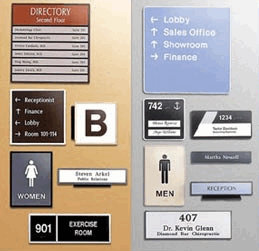ADA Signs: Vital Tools for Inclusive Settings
Checking Out the Secret Features of ADA Signs for Improved Access
In the realm of accessibility, ADA indications function as silent yet effective allies, ensuring that areas are accessible and comprehensive for individuals with impairments. By integrating Braille and tactile aspects, these indications damage obstacles for the visually impaired, while high-contrast color design and readable font styles accommodate varied visual needs. Moreover, their strategic placement is not arbitrary but instead a computed initiative to facilitate seamless navigation. Yet, beyond these attributes lies a deeper story concerning the development of inclusivity and the continuous dedication to developing equitable spaces. What much more could these indicators indicate in our quest of global availability?
Value of ADA Conformity
Making certain compliance with the Americans with Disabilities Act (ADA) is vital for cultivating inclusivity and equivalent gain access to in public rooms and work environments. The ADA, passed in 1990, mandates that all public facilities, employers, and transportation solutions accommodate individuals with impairments, guaranteeing they delight in the same legal rights and possibilities as others. Conformity with ADA requirements not only meets legal responsibilities but likewise enhances a company's track record by showing its dedication to diversity and inclusivity.
One of the essential facets of ADA conformity is the application of accessible signage. ADA indicators are developed to guarantee that individuals with handicaps can quickly navigate with buildings and areas. These indications need to stick to specific guidelines relating to dimension, font, shade contrast, and placement to ensure visibility and readability for all. Appropriately carried out ADA signage aids remove barriers that people with handicaps commonly run into, thereby advertising their self-reliance and self-confidence (ADA Signs).
Furthermore, sticking to ADA laws can mitigate the danger of legal repercussions and prospective penalties. Organizations that stop working to abide by ADA guidelines might face fines or claims, which can be both harmful and financially burdensome to their public photo. Hence, ADA conformity is indispensable to promoting a fair atmosphere for every person.
Braille and Tactile Components
The unification of Braille and tactile aspects right into ADA signs symbolizes the principles of availability and inclusivity. It is generally placed underneath the corresponding message on signs to ensure that individuals can access the info without visual aid.
Tactile elements expand beyond Braille and include increased signs and characters. These elements are designed to be noticeable by touch, allowing people to determine area numbers, bathrooms, exits, and various other important areas. The ADA establishes details standards regarding the size, spacing, and positioning of these responsive elements to maximize readability and guarantee uniformity across various atmospheres.

High-Contrast Color Pattern
High-contrast color design play a crucial function in improving the visibility and readability of ADA signs for people with visual disabilities. These plans are vital as they make the most of the difference in light reflectance between message and background, making sure that indications are quickly discernible, even from a range. The Americans with Disabilities Act (ADA) mandates the usage of details shade contrasts to suit those with limited vision, making it a vital aspect of compliance.
The efficiency of high-contrast shades depends on their capacity to stand out in different illumination conditions, consisting of poorly lit settings and locations with glow. Normally, dark text on a light history or light text on a dark background is employed to achieve optimum comparison. Black text on a white or yellow history provides a plain visual distinction that aids in fast recognition and comprehension.

Legible Fonts and Text Dimension
When thinking about the design of ADA signage, the option of legible font styles and ideal message dimension can not be overstated. These aspects are crucial for ensuring that indicators are available to people with aesthetic impairments. The Americans with Disabilities Act (ADA) mandates that fonts must be not italic and sans-serif, oblique, manuscript, extremely decorative, or of unusual form. These demands aid make sure that the text is quickly legible from a distance and that the characters are distinguishable to varied target markets.
The size of the message additionally plays a pivotal role in availability. According to ADA standards, the minimum message height must be 5/8 inch, and it needs to raise proportionally with viewing range. This is specifically important in public spaces where signage demands to be read swiftly and properly. Uniformity in text size contributes to a natural visual experience, assisting people in browsing atmospheres efficiently.
Moreover, spacing between letters and lines is indispensable to readability. Adequate spacing stops personalities from showing up crowded, enhancing readability. By sticking to these requirements, designers can substantially improve access, ensuring that signs offers its intended objective for all individuals, no matter their aesthetic capabilities.
Reliable Placement Techniques
Strategic placement of ADA signage is necessary for making the most of ease of access and guaranteeing conformity with legal requirements. Read More Here Appropriately positioned indications assist people with handicaps efficiently, facilitating navigation in public areas. Trick factors to consider include elevation, exposure, and proximity. ADA guidelines specify that indications must be installed at an elevation between 48 to 60 inches from the ground to guarantee they are within the line of sight for both standing and seated individuals. This typical elevation array is critical for inclusivity, enabling mobility device individuals and individuals of differing heights to accessibility information easily.
In addition, indicators need to be placed adjacent to the lock check that side of doors to allow very easy identification prior to entry. Uniformity in sign placement throughout a center enhances predictability, lowering complication and boosting overall user experience.

Conclusion
ADA signs play a crucial duty in promoting availability by incorporating attributes that address the requirements of people with impairments. Incorporating Braille and tactile elements ensures essential details comes to the visually impaired, while high-contrast shade plans and readable sans-serif font styles improve visibility throughout different lights conditions. Effective placement approaches, such as suitable installing elevations and critical locations, even more promote navigation. These aspects collectively promote an inclusive atmosphere, emphasizing the value of ADA compliance in making certain equivalent gain access to for all.
In the world of availability, ADA click this link indications serve as silent yet effective allies, making certain that areas are accessible and comprehensive for individuals with specials needs. The ADA, passed in 1990, mandates that all public centers, companies, and transportation solutions accommodate people with impairments, ensuring they appreciate the exact same rights and opportunities as others. ADA Signs. ADA indicators are designed to make sure that people with disabilities can quickly navigate via structures and areas. ADA guidelines state that indicators must be placed at a height between 48 to 60 inches from the ground to ensure they are within the line of view for both standing and seated individuals.ADA indications play an important duty in advertising access by integrating attributes that deal with the needs of individuals with impairments